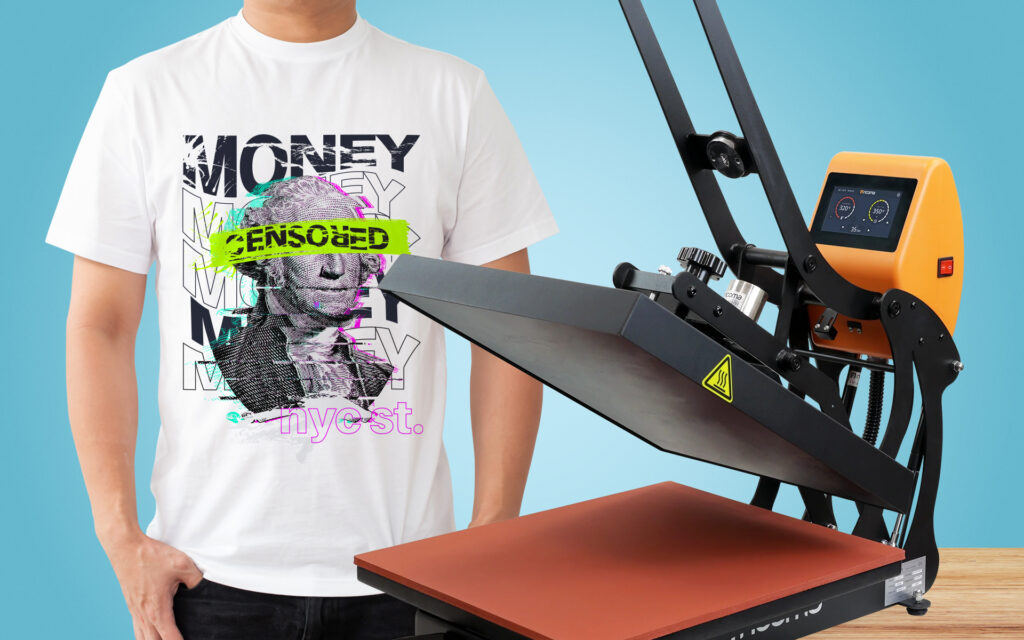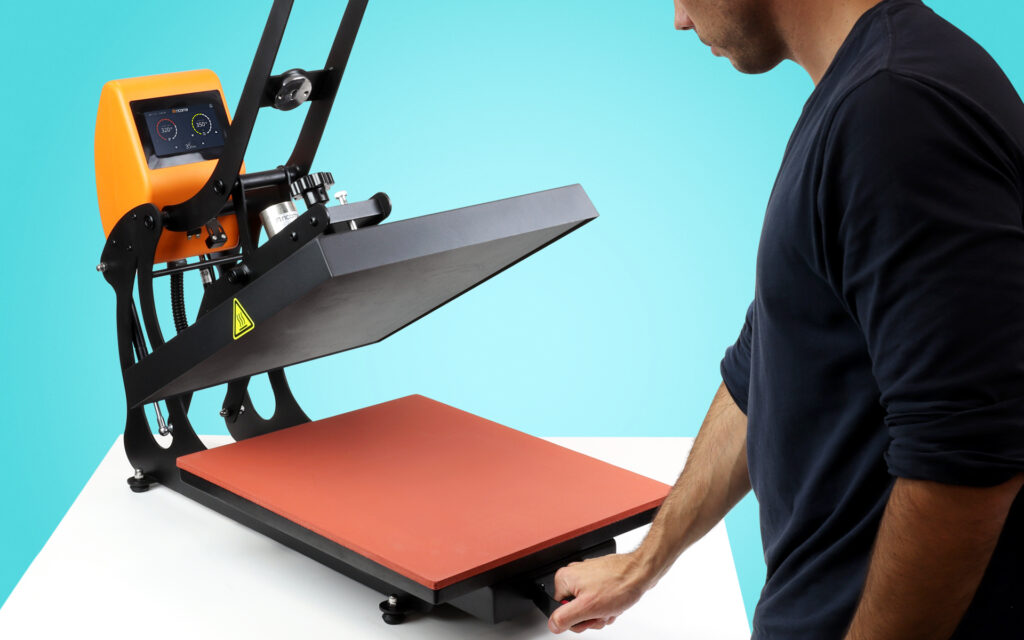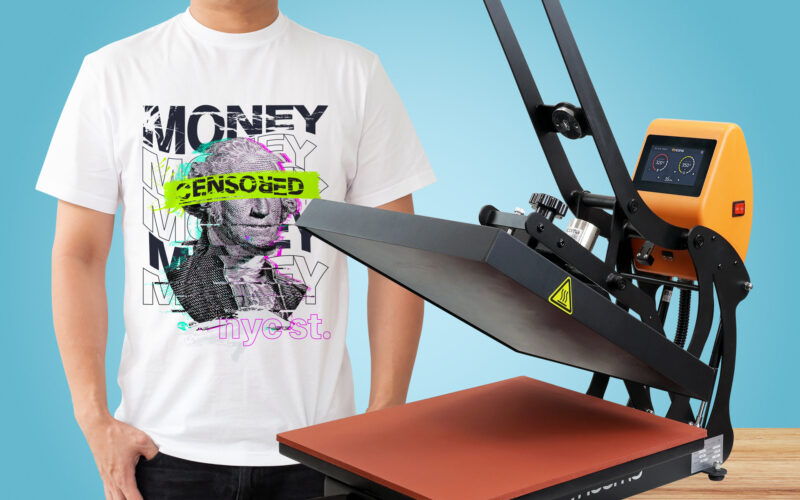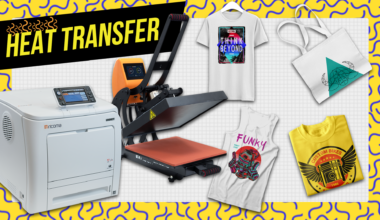Are you torn between the vibrant world of sublimation and the versatile realm of heat transfer for your printing projects?
Wondering which one is better worth your time, investment, and the future of your printing business? As a leader in the custom apparel industry, we have a bit to say about both processes and how they can help (or potentially slow down) your business.
So let’s talk about it— the great sublimation vs heat transfer debate!

What is Sublimation?
Sublimation is a printing technique where the ink is transformed into a gas through heat and pressure, bonding directly with the material. This process creates a permanent, high-quality print that is integrated seamlessly into the fabric or substrate.
When it comes to materials, sublimation is a bit picky.
It works best with polyester fabrics or items coated with a special polymer layer. This limitation is due to the nature of the sublimation process, which requires materials that can withstand high temperatures and bond effectively with the sublimation inks.
One of the standout advantages of sublimation is its durability. The prints are vibrant, sharp, and also resistant to fading and cracking over time. This makes sublimation an excellent choice for items that will see a lot of wear and tear, like sportswear or personalized mugs.
To get started with sublimation, you’ll need some specific equipment and supplies.
First, you’ll need a printer designed to use sublimation ink or toner. These inks are formulated to transition from solid to gas without becoming liquid, ensuring a smooth and precise transfer.
Additionally, you’ll need a heat press to apply the necessary heat and pressure to complete the sublimation process. While the initial investment might be higher than some other printing methods, the stunning and long-lasting results are well worth it!
What is 2-Step Heat Transfer Printing?
2-step heat transfer printing, also known as white toner transfer printing, is a method used in digital printing to transfer designs onto various surfaces, like garments, ceramics, and paper.
Unlike traditional printing methods that use ink, 2-step heat transfer printing uses a specialized printer with white toner cartridges. This allows for the printing of white designs or backgrounds on dark-colored or transparent materials, which is challenging with regular printers that rely on white paper for the background color. The process involves printing the design onto a special transfer paper and then using heat to transfer the design onto the desired surface.
To get started with white toner transfer printing, you’ll need a white toner transfer printer.
Let’s head into the dye sublimation vs heat transfer debate, and see who wins!
Sublimation vs. 2-Step Heat Transfer: The Biggest Differences
Process
When it comes to choosing between sublimation and heat transfer, understanding the differences in their processes is crucial.
Sublimation involves the direct bonding of ink to the material. In this method, the ink turns into gas under heat and pressure, penetrating the fabric or substrate and becoming part of its structure. In turn, you get a seamless and permanent print that’s integrated into the material.
2-step heat transfer (vs sublimation) involves the application of a separate layer onto the surface of the material. You’ll print the design onto transfer paper, and then apply it to the substrate using heat and pressure. Unlike sublimation, the design sits on top of the material, creating an additional layer.
For beginners, both processes have their learning curves.
Sublimation might be a bit more straightforward once the equipment is set up, as it involves fewer steps—print the design, press it onto the material, and you’re done. However, the initial setup and understanding of the specific materials and inks can be more complex.
2-step heat transfer might seem more accessible at first, as it’s similar to applying a sticker. However, working with transfer paper and aligning the designs can be tricky, and there’s a bit of an art to getting the pressure and heat settings just right.
✅ Both methods require practice and patience, but they offer different advantages and creative possibilities.

Materials
When it comes to the materials you can work with, there’s definitely going to be a noticeable difference between sublimation and heat transfer.
Sublimation is somewhat limited in its compatibility, working best with polyester fabrics or items that have a polymer coating. This is because the sublimation ink needs to bond with the material at a molecular level, which is most effective with these types of materials.
On the other hand, 2-step heat transfer is more versatile, allowing you to print on a broader range of fabrics, including cotton, polyester, and various blends.
The choice of material not only affects the compatibility with the printing method but also has a significant impact on the final product’s feel and appearance.
Most crafters know sublimation prints (vs heat transfer prints) for their smooth and seamless integration into the fabric, maintaining the original texture of the material. In contrast, heat transfer prints can sometimes have a noticeable texture, especially with vinyl transfers, which can add a layer on top of the fabric.
✅ Overall, the flexibility and broader range of products that you can use heat transfer on makes it a popular choice for a wider variety of projects.
Feel
The feel of the final product is an important consideration when choosing between sublimation and heat transfer.
Sublimated products have a smooth and integrated feel, as the ink becomes part of the material itself. This results in a print that is indistinguishable from the fabric, making it ideal for apparel where comfort is key, such as athletic wear or custom t-shirts.
Heat transfer products, on the other hand, can have a noticeable texture. The additional layer created by the transfer can be felt on the surface of the material, which might be less desirable for certain applications where a soft, seamless finish is preferred.
However, this texture can also add a unique tactile quality to the design, which might be appealing for decorative items or specialty products.
✅ Ultimately, the choice between sublimation and 2-step heat transfer will depend on the specific application and the desired feel of the final product. It’s important to consider how the material and printing method will affect the overall experience of using or wearing the finished item.
Longevity
Sublimation and heat transfer both produce high-quality, vibrant prints, particularly compared to other decorating methods.
✅ The sublimation process causes the ink to form a permanent bond with the fabric, essentially making the design a part of the garment. As a result, the design will generally last as long as the garment that it’s printed on.
In 2-step heat transfer, the design sits on top of the fabric. As a result, the design is more susceptible to cracking, chipping, and fading.
Cost and Complexity
Sublimation generally requires a higher initial investment, as you’ll need a sublimation printer, special inks, and a heat press. The ongoing costs include the price of sublimation paper and inks, which can be more expensive than those used for heat transfer.
However, the durability and quality of sublimated products often justify the higher costs.
2-step heat transfer printing can be more budget-friendly to start with. The equipment required, such as a heat press and vinyl cutter, can be less expensive than a sublimation setup. However, the costs of transfer paper, vinyl, and inks can add up over time, especially if you’re producing a large volume of prints.
In terms of complexity, both methods have their learning curves.
2-step heat transfer printing is often seen as more beginner-friendly, especially when working with vinyl, but achieving consistent, high-quality results still requires practice and attention to detail.
✅ However, sublimation is generally considered to be more technically complex due to the specific requirements for materials and the precise settings needed for the printer and heat press. Sublimation wins this round!

Final Thoughts: Sublimation vs. Heat Transfer Printing
So sublimation vs heat transfer— who gets the final verdict? Sublimation can produce vibrant, high-quality prints. Heat transfer can be more versatile, so the choice is dependent on what you’re using it for.
Consider using sublimation for…
- Polyester
- Polymer-coated items
- Long-lasting prints
- Durable results
- Seamless, professional finish
Consider using heat transfer for…
- Flexibility in design placement
- Wide range of materials
- Lower initial set-up cost
- Simple, straightforward method with food results
Find Your New Favorite Printer at Ricoma!
With practice and creativity, you’ll be able to master these techniques and bring your designs to life in no time! And with Ricoma’s all-in-one printing solutions, you can explore the tool that best works for your business.
Interested in learning more about screen printing vs heat transfer vs sublimation? Explore our YouTube channel to learn more about printing methods for your business!




